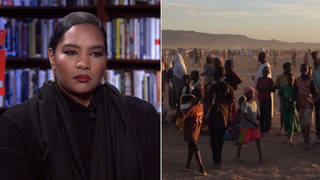
Guests
- Steve CollPulitzer Prize-winning journalist and managing editor of the Washington Post. He is the author several books, his latest is Ghost Wars: The Secret History of the CIA, Afghanistan, and Bin Laden, from the Soviet Invasion to September 10, 2001
During Reagan’s 8 years in power, the CIA secretly sent billions of dollars of military aid to the mujahedeen in Afghanistan in a US-supported jihad against the Soviet Union. We take a look at America’s role in Afghanistan that led to the rise of Osama bin Laden’s al Qaeda with Pulitzer prize-winning journalist Steve Coll, author of Ghost Wars: The Secret History of the CIA, Afghanistan, and Bin Laden, from the Soviet Invasion to September 10, 2001. [Includes transcript]
The body of former president Ronald Reagan arrived in Washington yesterday for America’s first state funeral in three decades. After landing at Andrews Air Force base, Reagan’s flag-draped coffin was taken on a final parade through Washington to the Capitol Rotunda. As many as 150,000 people are expected to view his casket before being returned to California tomorrow’s state funeral.
Vice President Dick Cheney opened the 34-hour period of Reagan’s lying in state by saying, “It was the vision and the will of Ronald Reagan that gave hope to the oppressed, shamed the oppressors and ended the evil empire.”
What Cheney along with the corporate media failed to mention yesterday was the Reagan administration’s role in financing, arming and training what was destined to become America’s worst enemy in the Middle East and Asia.
During most of the 1980’s, the CIA secretly sent billions of dollars of military aid to Afghanistan to support the mujahedeen–or holy warriors–against the Soviet Union, which had invaded in 1979.
The U.S.-supported jihad succeeded in driving out the Soviets but the Afghan factions allied to the US gave rise to the oppressive Taliban and Osama bin Laden’s al-Qaeda.
Today we take a look at America’s role in Afghanistan and the roots of 9/11 with Pulitzer prize-winning journalist Steve Coll. He is the managing editor of the Washington Post and the author of “Ghost Wars: The Secret History of the CIA, Afghanistan, and Bin Laden, from the Soviet Invasion to September 10, 2001.” Steve Coll joins us on the phone from his home in Washington.
Transcript
AMY GOODMAN: Steve Coll joins us on the line from Washington, DC. Welcome to Democracy Now!.
STEVE COLL: Thank you, Amy. Good morning.
AMY GOODMAN: Very good to have you with us. You write that the CIA, the KGB, Pakistan’s ISI and Saudi Arabia’s General Intelligence Department all operated directly and secretly in Afghanistan. They primed Afghan factions with cash and weapons, secretly trained guerrilla forces, funded propaganda and manipulated politics. In the midst of the struggles, Bin Laden conceived and built his global organization. Can you give us a thumbnail sketch of this history which you to say the least, very comprehensively deal with in “Ghost Wars?”
STEVE COLL: Well, it of course begins in 1979 when the Soviets invaded during the Carter administration, and it really swelled between 1981 and 1985. Essentially, under Bill Casey, the CIA created a three-part intelligence alliance to fund and arm the Mujahadeen, initially to harass Soviet occupation forces and eventually they embraced the goal of driving them out. The three-way alliance in each of the parties had a distinct role to play. The Saudi, their intelligence service primarily provided cash. Each year the congress would secretly allocate a certain amount of money to support the CIA’s program. After that allocation was complete, the US Intelligence liaison would fly to Riyadh and the Saudis would write a matching check. The US role was to provide logistics and technological support as well as money. The Saudis collaborated with Pakistan’s intelligence service, ISI, to really run the war on the front lines. It was the Pakistani army, in particular the ISI, that picked the political winners and losers in the jihad, and who favored radical Islamist factions because it suited the Pakistan’s army goal of pacifying Afghanistan, a long-time unruly neighbor to the west, whose ethnic Pashtun nationalism the army feared. The army saw Islam not only as a motivating force in the anti-Soviet jihad, but as an instrument of Pakistan’s regional policy to control Afghanistan. The US acquiesced with all of this in part because they thought that the only purpose that brought them to the region was to drive the Soviets out, and they didn’t really care about local politics. But also because after Vietnam, the generation of CIA officers involved in this program were scarred by their experiences in Southeast Asia, and they essentially operated under a mantra of no more hearts and minds for us. We’re not good at picking winners and losers in a developing world. Let’s let the Pakistanis decide who carries this jihad forward. That’s how the favoritism of the radical Islamic factions was born and nurtured.
JUAN GONZALEZ: Steve, at what point in this process did the Mujahadeen basically turn their guns around, and was the United States aware at the point in which their allies had become now — had begun to target them for their next jihad?
STEVE COLL: Yeah. That’s a good question. It happened gradually in the late 1980’s. Certainly, there were people in the early 1980’s involved in the program who were aware that many of America’s favorite clients were fundamentally anti-American in their outlook. But it was only in the late 1980’s as the amounts of money and guns and really the success of the jihad began to swell that clients such as Gulbuddin Hekmatyar and Abdul Sayyaf, who were two of the most vehemently anti-American leaders of the jihad began to explicitly turn their propaganda pamphlets, at least their rhetorical efforts, against the United States as well as against the Soviet Union. As that began to happen, to the second part of your question, there were individuals inside the US bureaucracy, at the state department, elsewhere, who began to warn that the United States needed to change its political approach to this covert action program, that they needed now to start getting involved in the messy business of Afghan politics and to start to promote more centrist factions and to negotiate compromise with the Soviet-backed communist government in Kabul to prevent Islamist extremists from coming to power as the Soviets withdrew. These warnings, when you look at them with the benefit of hindsight, are quite prescient and certainly were strongly given, but they languished in the middle of the bureaucracy and were largely ignored by both second term Reagan administration and the first Bush administration, Bush 41.
AMY GOODMAN: We’re talking to Steve Coll. He is managing editor of the Washington Post, and he has written a book, Ghost wars — The Secret History of the CIA, Afghanistan and Bin Laden, from the Soviet Invasion to September 10, 2001. Can you talk about the role of Kashmir in all of this as the conflict in Kashmir?
STEVE COLL: After the Soviets withdrew in 1988, the Pakistan army and intelligence service interpreted this victory as essentially providing them a model for combating their neighbor to the east, India, a country with much larger standing army, much greater industrial potential and a much larger population base, but threatened, at least in the Pakistan army’s view, Pakistan’s national existence. As a spontaneous indigenous rebellion against corrupt Indian rule began in Kashmir in 1989, the Pakistan army and intelligence service began to pour in support for Islamism factions using not only the model of the anti-soviet jihad in Afghanistan, but also many of the training camp facilities that had been built up to support the Afghanistan war. They also used same Muslim brotherhood influence networks to essentially take over the Kashmir rebellion and try to turn it into an instrument of Pakistan’s national policy, an effort in which they were partially successful by the mid 1990’s. So, what it means as a practical matter, looking at al-Qaeda, is that as Bin Laden began to use the sanctuary of Afghanistan to develop his global ambitions and his global organization, he found indirect and sometimes direct support from the Pakistan army which sought to use his infrastructure to run their own jihad in Kashmir. The Pakistan army’s purpose in Kashmir was to support what they viewed as the liberation of an occupied territory, but sometimes more cynically, they thought to tie down the Indian army in Kashmir, and they succeeded. They tied down 600,000 Indian troops by running the cross-border Islamist jihad they rehearsed, in effect, in Afghanistan.
JUAN GONZALEZ: Steve, I’d like to ask you, to what degree was the US policy in supporting the Mujahadeen, or its policy in Pakistan an aberration and to what degree was it a continuation of policy in the Middle East. I don’t know if you have read the book by Tariq Ali, The Clash of Fundamentalisms where he posits that this has been a historical pattern in the Middle East, that the British and United States have supported right wing or religious or — or organizations and groups covertly or sometimes overtly to stop modernist governments such as Nasser in Egypt or Gandhi in India as well as a leftist oriented governments in the region. Has this been a historical pattern?
STEVE COLL: Yes. I think there is a pattern of that kind. It’s not comprehensive, but it’s certainly prevalent through the history that you refer to. In the Cold War period, I think there was a real belief, certainly by Bill Casey, who was a devout catholic and by the Saudi royal family, that the support of religious networks and organizations against soviet supported either communist or leftist governments was not only good tactics, but it was also righteous. It was the battle of the faithful against the godless was really, I think, at some personal level, how Casey and some of the Saudis saw it. As you say, that wasn’t spontaneous idea. It was rooted in approaches that governments had taken, the British and the United States, when secular socialist governments had risen in the Middle East earlier. The British certainly supported the Muslim Brotherhood as an instrument of challenge against Nasser once they were concerned about Nasser’s ambitions. At the same time, the Muslim Brotherhood had been born as an anti-colonial, anti-British force, so the pendulum swung both ways. During the 1980’s, it’s generally agreed now, though a lot of the details are not available, that the Israelis supported Hamas covertly as an instrument of sort of a covert program to create a rival movement within the Palestinian community against the PLO. Now presumably they regret that strategy as well.
AMY GOODMAN: How did the Reagan administration — how did President Reagan describe what was happening in Afghanistan during the time? What awareness did Americans have of what was going on in the 1980’s in Afghanistan and the US support for the Mujahadeen?
STEVE COLL: It’s interesting to go back and look at the public discourse about this. During the Reagan years in particular, it was a very superficial, certainly, Reagan often used the terminology of his, you know of freedom. These were freedom fighters. These were noble freedom fighters. I don’t want to overstate this, but the Afghans were regarded with some distance almost as noble savages in some sort of a state of purity fighting for an abstract idea of freedom. The idea that Afghanistan was a messy place filled with complexity and ethnicity and tribal structures and all of the rest of what we now understand about Afghanistan was it was generally not part of American public discourse. By contrast, the covert wars in Central America were much richer controversies in the United States, and they were often discussed in much greater detail and nuance in Congress and elsewhere. Of course, the support for the Contras became a raging controversy by the second term of the Reagan administration. Afghanistan never became such a program. It attracted bipartisan support and a general quietude throughout. In part because it was so far away, in part because the war was one between an occupied people and the soviet army. This is not a — this is not proxies on both side. This is a direct invasion that was generally regarded at unjust across the developing world. Also, the United States didn’t play a very direct role on the front lines of the jihad. There were not Americans in tennis shoes generally standing up on the paths getting shot or creating episodes. This was a war in which the United States acted as quartermaster and let the Pakistani intelligence service run things on the front lines.
AMY GOODMAN: Steve Coll, I want to thank you very much for being with us. Steve Coll is the author of Ghost Wars — The Secret History of the CIA, Afghanistan and Bin Laden from the Soviet Invasion to September 10, 2001. He’s the managing editor of the Washington Post.













Media Options